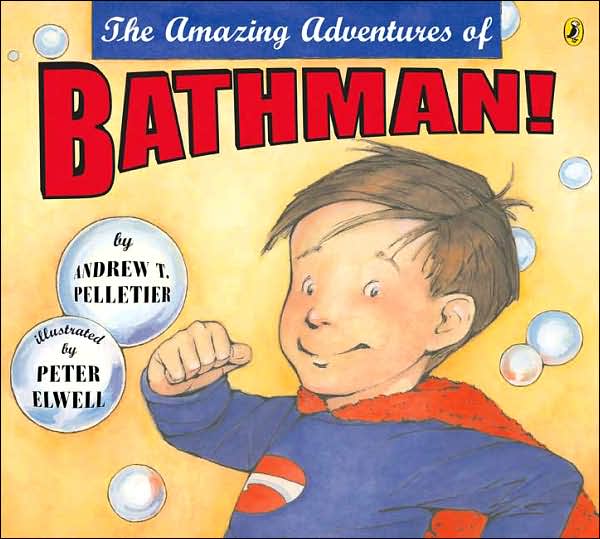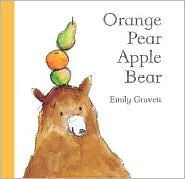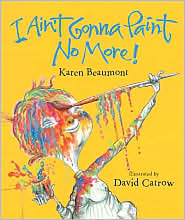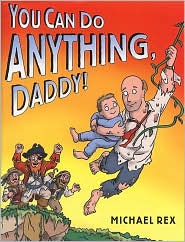Early Literacy Aside--Explain: Our Early Literacy Tip of the Day is on print motivation or showing children how to love books. You know that kids love to read the same book over and over. This is how children learn, so go ahead and read Dora the Explorer or their favorite book one more time. Your kids will love you for it.Early Literacy Aside--Empower: As you leave, please pick up a book from the table and read it with your child. If for some reason your child is not interested, don't force it on her. Find something she is interested in or wait until your child is ready to listen. It's OK to not finish a book! Don't make it a chore that needs to be done.
Submitted by Kim Connett, Marion (OH) Public Library


 Early Literacy Aside--Explain: We are going to have fun playing with sounds today, reading stories with sound words. Playing with sounds helps develop phonological awareness which will help your child learn to hear the smaller sounds in words.Read book emphasizing sound words like crunch and munch. Then I go back to some pages and have the children say the words with me, again emphasizing different sounds.
Early Literacy Aside--Example: Hearing and learning sound words like splish-splash is an enjoyable way of learning phonlogical awareness and will help your children later hear smaller sounds in words.
Early Literacy Aside--Empower: At home, play with sound words, like splish-splash in the bath, crunch-munch at snack, and exaggerate how you are saying words to practice hearing their parts.
Early Literacy Aside--Explain: We are going to have fun playing with sounds today, reading stories with sound words. Playing with sounds helps develop phonological awareness which will help your child learn to hear the smaller sounds in words.Read book emphasizing sound words like crunch and munch. Then I go back to some pages and have the children say the words with me, again emphasizing different sounds.
Early Literacy Aside--Example: Hearing and learning sound words like splish-splash is an enjoyable way of learning phonlogical awareness and will help your children later hear smaller sounds in words.
Early Literacy Aside--Empower: At home, play with sound words, like splish-splash in the bath, crunch-munch at snack, and exaggerate how you are saying words to practice hearing their parts. Book Introduction: Start with book upside down. Children will say to "turn it the right way". If not, look at the upside-down book and say, "Oh I can't read it like this, I have to turn it right side up. Read title and point out author/illustrator, running finger under the words.
Book Introduction: Start with book upside down. Children will say to "turn it the right way". If not, look at the upside-down book and say, "Oh I can't read it like this, I have to turn it right side up. Read title and point out author/illustrator, running finger under the words.
 Early Literacy Aside--Explain: Research shows that there are early literacy skills that influence a child's ability to learn to read. Today, you will probably notice several places where I demonstrate examples of narrative skills, which is the ability to describe things and events and to tell stories. When you develop this skill, it will help your children understand what they reads later.Song: Bop 'Til You Drop
Go through the sequence of motions that are in the song, Bop 'Til You Drop
Early Literacy Aside--Example: Singing songs that have a certain order is one great way for children to remember the sequence or order of things. They will use the same skill when they retell a story. They learn how stories work.
Early Literacy Aside--Empower: One thing that you can do at home to develop narrative skills is to describe regular activities such as taking a bath--"first we'll get out the towel, then we'll put the water in the tub and add the bubbles/toys, then we'll take off your clothes, and get in the water. We can scrub our toes, our ears . . . " With older kids, let THEM describe the sequence of events with prompts like, "What do we have to do before we put the bubbles in? or "What do we do next?"
Early Literacy Aside--Explain: Research shows that there are early literacy skills that influence a child's ability to learn to read. Today, you will probably notice several places where I demonstrate examples of narrative skills, which is the ability to describe things and events and to tell stories. When you develop this skill, it will help your children understand what they reads later.Song: Bop 'Til You Drop
Go through the sequence of motions that are in the song, Bop 'Til You Drop
Early Literacy Aside--Example: Singing songs that have a certain order is one great way for children to remember the sequence or order of things. They will use the same skill when they retell a story. They learn how stories work.
Early Literacy Aside--Empower: One thing that you can do at home to develop narrative skills is to describe regular activities such as taking a bath--"first we'll get out the towel, then we'll put the water in the tub and add the bubbles/toys, then we'll take off your clothes, and get in the water. We can scrub our toes, our ears . . . " With older kids, let THEM describe the sequence of events with prompts like, "What do we have to do before we put the bubbles in? or "What do we do next?" Ten little campers make a ring. (Form circle putting tips of fingers together and thumbs together)
Ten little campers start to sing. (Cup hands to mouth)
Ten little campers around the fire. (Form circle putting tips of fingers together again)
Ten little campers dance till they tire. (Put all ten fingers up in the air and dance them around)
Ten little campers say good-night. (Wave good-night with both hands)
Ten little campers close their tent up tight. (Intertwine fingers together again to signify closure)
Early Literacy Aside--Example: Rhymes are fun to sing and say with your child. Because they rhyme, they also help children develop phonological awareness, an important skill for later reading when they try to sound out words.
Ten little campers make a ring. (Form circle putting tips of fingers together and thumbs together)
Ten little campers start to sing. (Cup hands to mouth)
Ten little campers around the fire. (Form circle putting tips of fingers together again)
Ten little campers dance till they tire. (Put all ten fingers up in the air and dance them around)
Ten little campers say good-night. (Wave good-night with both hands)
Ten little campers close their tent up tight. (Intertwine fingers together again to signify closure)
Early Literacy Aside--Example: Rhymes are fun to sing and say with your child. Because they rhyme, they also help children develop phonological awareness, an important skill for later reading when they try to sound out words. Early Literacy Aside--Example: Having your child say a repeated phrase with you throughout the book keeps him involved. This is a great way to keep your booksharing time fun and it supports print motivation--that enjoyment of reading. Participation keeps them interested.Read Bear Wants More and have the children chime in with the repeated phrase.
Early Literacy Aside--Example: Having your child say a repeated phrase with you throughout the book keeps him involved. This is a great way to keep your booksharing time fun and it supports print motivation--that enjoyment of reading. Participation keeps them interested.Read Bear Wants More and have the children chime in with the repeated phrase. Early Literacy Aside--Example: Print motivation is an interest in and enjoyment of books. Children need this skill prior to formal reading instruction. One way to develop this skill is to use pop-up books and other books that provide surprises. Let's see what surprises this book brings.Read Wide-Mouthed Frog.
Early Literacy Aside--Example: Print motivation is an interest in and enjoyment of books. Children need this skill prior to formal reading instruction. One way to develop this skill is to use pop-up books and other books that provide surprises. Let's see what surprises this book brings.Read Wide-Mouthed Frog. Early Literacy Aside--Example: When you choose books for your children, they like the ones that have pictures of things that are familiar to them. So, here is one with a picture of an apple. You can talk about the apple in the picture, its color, its shape. Then get a real apple and show it to your child. Talk about how it tastes--sweet, how it feels--round and smooth, the sound it makes when you bite it--CRUNCH!By showing your child the real object, you are helping them realize that pictures represent real things. Later they will also understand that printed words represent real things as well. This develops print awareness. I'll read this story to you once, then we'll use the flannel board to tell it again!
Read Orange Pear Apple Bear by Emily Gravett
Early Literacy Aside--Example: When you choose books for your children, they like the ones that have pictures of things that are familiar to them. So, here is one with a picture of an apple. You can talk about the apple in the picture, its color, its shape. Then get a real apple and show it to your child. Talk about how it tastes--sweet, how it feels--round and smooth, the sound it makes when you bite it--CRUNCH!By showing your child the real object, you are helping them realize that pictures represent real things. Later they will also understand that printed words represent real things as well. This develops print awareness. I'll read this story to you once, then we'll use the flannel board to tell it again!
Read Orange Pear Apple Bear by Emily Gravett
 Talk about spiders and how they spin their webs. Each web is different. They use their webs to catch their food.Read the book The Very Busy Spider by Eric Carle.
Put up pieces on a flannel board, having the participants retell the story as you put up the pieces.
Early Literacy Aside--Example: This book has lots of repetition so it is a good one for retelling. I have a handout with the same figures that I used on the flannel board. I will also pass out some yarn to make the web. You can cut out the figures and use the yarn to retell the story. Helping your children to retell stories will help them understand what they read later in school.
Talk about spiders and how they spin their webs. Each web is different. They use their webs to catch their food.Read the book The Very Busy Spider by Eric Carle.
Put up pieces on a flannel board, having the participants retell the story as you put up the pieces.
Early Literacy Aside--Example: This book has lots of repetition so it is a good one for retelling. I have a handout with the same figures that I used on the flannel board. I will also pass out some yarn to make the web. You can cut out the figures and use the yarn to retell the story. Helping your children to retell stories will help them understand what they read later in school. Early Literacy Aside--Example: As I read this story, I am going to pause and have the children fill in the rhyming word. This is something you can easily do with rhyming books. Start off by using rhyming books that your child has read with you before. Helping your children hear rhymes will help them later to sound out words when they learn to read!Read the book: As you read the book, let the children chime in with some of the rhyming words, like head to follow red.
After the book activity: Everyone stand up! What's a word that rhymes with head? Children give suggestions. Pick one--bed. OK, take your hand and dip it in red paint on the floor (pretend). Now take your hand and draw a bed. Good! What's a word that rhymes with green? Perhaps the children say bean. OK, dip your foot in some green paint on the floor, and draw a bean. We all laugh together.
Early Literacy Aside--Example: As I read this story, I am going to pause and have the children fill in the rhyming word. This is something you can easily do with rhyming books. Start off by using rhyming books that your child has read with you before. Helping your children hear rhymes will help them later to sound out words when they learn to read!Read the book: As you read the book, let the children chime in with some of the rhyming words, like head to follow red.
After the book activity: Everyone stand up! What's a word that rhymes with head? Children give suggestions. Pick one--bed. OK, take your hand and dip it in red paint on the floor (pretend). Now take your hand and draw a bed. Good! What's a word that rhymes with green? Perhaps the children say bean. OK, dip your foot in some green paint on the floor, and draw a bean. We all laugh together. Read the book You Can Do Anything, Daddy by Michael Rex.Craft/Activity: In this book, the boy is thinking of bad things that might happen to him. His father is figuring out how to save his son. I am giving each of you [adults and children] a piece of paper. On one side I want you to draw something you think of that is scary for you. On the other side I want you to think of something your a grownup could do to help you. It is all pretend, make-believe. What can you think of?
Eary Literacy Aside: Having your children draw and then tell you about what they drew develops their narrative skills. It also gives us a window into their thoughts. You can also write down what your children say with the picture so that they make the connection between the written and the spoken word. This helps develop their print awareness, knowing that print has meaning.
Read the book You Can Do Anything, Daddy by Michael Rex.Craft/Activity: In this book, the boy is thinking of bad things that might happen to him. His father is figuring out how to save his son. I am giving each of you [adults and children] a piece of paper. On one side I want you to draw something you think of that is scary for you. On the other side I want you to think of something your a grownup could do to help you. It is all pretend, make-believe. What can you think of?
Eary Literacy Aside: Having your children draw and then tell you about what they drew develops their narrative skills. It also gives us a window into their thoughts. You can also write down what your children say with the picture so that they make the connection between the written and the spoken word. This helps develop their print awareness, knowing that print has meaning. Before reading the book: Ask the children to describe things they would put in a box. And in this box it will contain art supplies. What can you think of? They reply with crayons, paint, etc. This is a great way for children to use the vocabulary that they do know and also good for developing Narrative Skills, which is the ability to describe events and tell stories. Now let's see how a book can help introduce children to new vocabulary.Read the book Art Box by Gail Gibbons.
Have items like compass, protractor, etc. available for the children to see and use. Talk about what they do.
Early Literacy Aside--Empower: Parents, having real objects to help children understand words in the book is one way to help build their vocabulary, to learn the meanings of words. Even when you are not reading books, just talking about objects around the house and what they do is one way to expand children's understanding.
Before reading the book: Ask the children to describe things they would put in a box. And in this box it will contain art supplies. What can you think of? They reply with crayons, paint, etc. This is a great way for children to use the vocabulary that they do know and also good for developing Narrative Skills, which is the ability to describe events and tell stories. Now let's see how a book can help introduce children to new vocabulary.Read the book Art Box by Gail Gibbons.
Have items like compass, protractor, etc. available for the children to see and use. Talk about what they do.
Early Literacy Aside--Empower: Parents, having real objects to help children understand words in the book is one way to help build their vocabulary, to learn the meanings of words. Even when you are not reading books, just talking about objects around the house and what they do is one way to expand children's understanding. Book Introduction: In our next book, there is a mother hen and her three chicks, one is a Big Chick, one the Middle Chick, and lastly the Little Chick. The Little Chick likes to run on tiptoes, very quickly. Everyone stand up. Let me see you run in place, just where you are standing. Great! Now let me see you stand on tiptoe. That's right you don't touchyour heel to the floor. Now run in place again, but on tiptoe--that's how Little Chick runs. Everyone sit down and let's see what happens. In this book there are sounds like RUFF-RUFF that the dog makes. Let me hear you say that. Great! For Little Chick the sound is tippy-toe, tippy-toe, tippy-toe. Let me hear you say that. Great!OK, ready?! As I read the book you'll be making these sounds. Listen to the story too and see how smart Little Chick is.
Read the story Tippie-Toe Chick, Go! by George Shannon.
Early Literacy Aside--Example: Having your children make the sounds of animals and other sounds helps them develop phonological awareness, being able to hear the smaller sounds in words. This is so important when they later try to sound out words.
Book Introduction: In our next book, there is a mother hen and her three chicks, one is a Big Chick, one the Middle Chick, and lastly the Little Chick. The Little Chick likes to run on tiptoes, very quickly. Everyone stand up. Let me see you run in place, just where you are standing. Great! Now let me see you stand on tiptoe. That's right you don't touchyour heel to the floor. Now run in place again, but on tiptoe--that's how Little Chick runs. Everyone sit down and let's see what happens. In this book there are sounds like RUFF-RUFF that the dog makes. Let me hear you say that. Great! For Little Chick the sound is tippy-toe, tippy-toe, tippy-toe. Let me hear you say that. Great!OK, ready?! As I read the book you'll be making these sounds. Listen to the story too and see how smart Little Chick is.
Read the story Tippie-Toe Chick, Go! by George Shannon.
Early Literacy Aside--Example: Having your children make the sounds of animals and other sounds helps them develop phonological awareness, being able to hear the smaller sounds in words. This is so important when they later try to sound out words. Book Introduction: Our next book is Don't Worry Bear by Greg Foley. [Run your finger under the title.] In this book the caterpillar says the words "Don't worry, bear" over and over again. Let's practice saying that--"Don't worry. bear." Good! . . .As I read the book, I'll point to you all and you'll know to say, "Don't worry, bear." [As you read the book run your finger under the words don't worry bear, as they say these words.]
Early Literacy Aside--Example: You noticed that I ran my finger under the words don't worry bear each time you all said those words. This helps develop your children's print awareness, knowing that print has meaning and that it is the words we read. You can do this with any book you read!
Book Introduction: Our next book is Don't Worry Bear by Greg Foley. [Run your finger under the title.] In this book the caterpillar says the words "Don't worry, bear" over and over again. Let's practice saying that--"Don't worry. bear." Good! . . .As I read the book, I'll point to you all and you'll know to say, "Don't worry, bear." [As you read the book run your finger under the words don't worry bear, as they say these words.]
Early Literacy Aside--Example: You noticed that I ran my finger under the words don't worry bear each time you all said those words. This helps develop your children's print awareness, knowing that print has meaning and that it is the words we read. You can do this with any book you read!